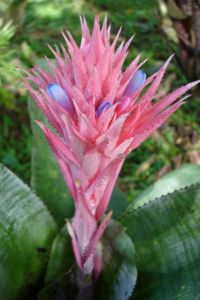Aechmea: Difference between revisions
No edit summary |
No edit summary |
||
| Line 1: | Line 1: | ||
{{inc| | |||
Aechmea (from aichme, point; referring to the rigid points on the calyx). Bromeliaceae. Epiphytic herbs, of about sixty species, natives of tropical South America, grown in choice greenhouse collections. | |||
Flower-cluster arising from a cluster or rosette of long, hard lvs. which are serrate; petals 3, tongue- shaped, obtuse or pointed, 2-3 times the length of the spine-pointed calyx-lobes; stamens 6, shorter than the petals; ovary inferior, 3-celled. The fls. are subtended by (in the axils of) fl.-bracts; the entire head or fl.- cluster is often reinforced or subtended by conspicuous lf.-bracts; in the compound-infl. types, the individual branches are usually subtended by branch-bracts. In some species, as A. Lalindei and A. Mariae-Reginae, the large colored lf.-bracts are the most conspicuous part of the plant. In others, as A. Veitchii, the entire head is the showy part. Monogr. by Baker, Journ. Bot. 1879:129, 161,226. Includes Canistrum, Echinostachys, Hohenbergia, Hoplophytum, Lamprococcus, Pironneava, Pothuava; and some of the species have been referred to Billbergia, Cryptanthus, Guzmannia, Tillandsia, Chevaliera, and others. | |||
The aechmeas are closely allied to the billbergias, from which they are distinguished by smaller flowers, which are little exserted from the calyx and not widely expanding, short filaments and small anthers, sharp-pointed sepals and conspicuous sharp-pointed flower-bracts. | |||
For culture, see Billbergia. | |||
}} | |||
__NOTOC__{{Plantbox | __NOTOC__{{Plantbox | ||
| name = Aechmea | | name = Aechmea | ||
Revision as of 02:08, 2 July 2009
| Standard Cyclopedia of Horticulture |
|---|
|
Aechmea (from aichme, point; referring to the rigid points on the calyx). Bromeliaceae. Epiphytic herbs, of about sixty species, natives of tropical South America, grown in choice greenhouse collections. Flower-cluster arising from a cluster or rosette of long, hard lvs. which are serrate; petals 3, tongue- shaped, obtuse or pointed, 2-3 times the length of the spine-pointed calyx-lobes; stamens 6, shorter than the petals; ovary inferior, 3-celled. The fls. are subtended by (in the axils of) fl.-bracts; the entire head or fl.- cluster is often reinforced or subtended by conspicuous lf.-bracts; in the compound-infl. types, the individual branches are usually subtended by branch-bracts. In some species, as A. Lalindei and A. Mariae-Reginae, the large colored lf.-bracts are the most conspicuous part of the plant. In others, as A. Veitchii, the entire head is the showy part. Monogr. by Baker, Journ. Bot. 1879:129, 161,226. Includes Canistrum, Echinostachys, Hohenbergia, Hoplophytum, Lamprococcus, Pironneava, Pothuava; and some of the species have been referred to Billbergia, Cryptanthus, Guzmannia, Tillandsia, Chevaliera, and others. The aechmeas are closely allied to the billbergias, from which they are distinguished by smaller flowers, which are little exserted from the calyx and not widely expanding, short filaments and small anthers, sharp-pointed sepals and conspicuous sharp-pointed flower-bracts. For culture, see Billbergia.
|
Aechmea {{{latin_name}}}
|
'
| ||||||||||||||||||||||||||||||||||||||||
|---|---|---|---|---|---|---|---|---|---|---|---|---|---|---|---|---|---|---|---|---|---|---|---|---|---|---|---|---|---|---|---|---|---|---|---|---|---|---|---|---|---|

|
|
| |||||||||||||||||||||||||||||||||||||||
| |||||||||||||||||||||||||||||||||||||||||
- Do you have a description of this genus or plant? Edit this section!
- More information about this species can be found on the genus page.
Cultivation
| calendar? | ||
|---|---|---|
| January: | ||
| February: | ||
| March: | ||
| April: | ||
| May: | ||
| June: | ||
| July: | ||
| August: | ||
| September: | ||
| October: | ||
| November: | ||
| December: | ||
| Notes: | ||
- Do you have cultivation info on this plant? Edit this section!
Grow in shady spot with great air circulation. Soil should retain water, and be watered when dry to touch. Water should be poured into cups of leaves regularly. Can be grown in soil, pots, moss in the crotch of trees.
Propagation
- Do you have propagation info on this plant? Edit this section!
Pests and diseases
- Do you have pest and disease info on this plant? Edit this section!
Species
Aechmea has more than 140 species distributed from Mexico through South America. Most of the species in this genus are epiphytes.
- Aechmea abbreviata
- Aechmea aciculosa
- Aechmea angustifolia
- Aechmea apocalyptica
- Aechmea aquilegia
- Aechmea beeriana
- Aechmea blanchetiana
- Aechmea blumenavii
- Aechmea bracteata
- Aechmea bromeliifolia
- Aechmea caesia
- Aechmea calyculata
- Aechmea candida
- Aechmea caudata
- Aechmea chantinii - Amazonian Zebra Plant
- Aechmea coelestis
- Aechmea cylindrata
- Aechmea dealbata
- Aechmea distichantha - Brazilian Vaseplant, Vase Plant
- Aechmea drakeana
- Aechmea emmerichiae
- Aechmea fasciata - Silver-Vase, Urn Plant
- Aechmea filicaulis
- Aechmea flavorosea
- Aechmea fosteriana - Lacquered Wine Cup, Foster's Bromeliad
- Aechmea fulgens - Coralberry
- Aechmea gamosepala
- Aechmea hoppi
- Aechmea kentii
- Aechmea kleinii
- Aechmea kuntzeana
- Aechmea lindenii
- Aechmea lingulata
- Aechmea longifolia
- Aechmea lueddemanniana
- Aechmea magdalenae
- Aechmea mariae-reginae
- Aechmea mexicana
- Aechmea miniata
- Aechmea mulfordii - Living Vase Bromelia
- Aechmea nudicaulis
- Aechmea orlandiana
- Aechmea pedicellata
- Aechmea perforata
- Aechmea pimenti-velosii
- Aechmea pineliana
- Aechmea purpureorosea
- Aechmea recurvata
- Aechmea rodriguesiana
- Aechmea spectabilis
- Aechmea tillandsioides
- Aechmea veitchii
- Aechmea victoriana
- Aechmea weilbachii
- Aechmea zebrina
Gallery
If you have a photo of this plant, please upload it! Plus, there may be other photos available for you to add.
-
photo 1
-
photo 2
-
photo 3
References
External links
- w:Aechmea. Some of the material on this page may be from Wikipedia, under the Creative Commons license.
- Aechmea QR Code (Size 50, 100, 200, 500)
